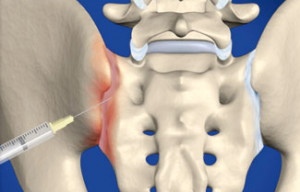Pain coming from the sacroiliac joint is very common. Thankfully, there are excellent treatment options for SI joint pain. Research has shown that between 12 to 25% of low back pain emanates from the sacroiliac joint. (Cohen et al., Sacroiliac Joint Pain: A Comprehensive Review of Anatomy, Diagnosis, and Treatment.?Anesth Analg 2005)
Where exactly is the Sacroiliac Joint (SI Joint)?
There are two SI joints in the human body. They are located at the lowest part of the back on the right and left side where the pelvic bone meets up with the sacrum. These joints contain cartilage just like the hip or the knee. The joints themselves tend to be fairly irregular and almost jagged in shape.
How much movement occurs in the SI joints?on the right and left side where the pelvic bone meets up with the sacrum. These joints contain cartilage just like the hip or the knee. The joints themselves tend to be fairly irregular and almost jagged in shape.
These joints are not like the hip or the knee. They contain articular cartilage, but they only move about 2 to 4 mm in any one particular direction. The hip and thigh experience exponentially more movement than this. Despite the fact that the sacroiliac joint has less motion, it can still experience significant pain with even that micromotion when arthritis is present.
Call (602) 507 – 6550 to schedule your Appointment TODAY!

Why does one develop pain from the sacroiliac joint?
Since SI joints contain cartilage just like any other joint in the body, they are prone to arthritis. A person may develop pain due to either degenerative arthritis or after a trauma such as a fall or an auto accident.
This is by far the most common reason that people develop pain in this area. Much less commonly a person may have a fracture, tumor or an infection.
How does sacroiliac joint pain get diagnosed?
When a person says they have pain over the sacroiliac joint, it may simply be referred pain from a problem in the lumbar spine. Therefore the pain doctor will need to be proactive in making the diagnosis.
Physical exam may show pain with provocative maneuvers for the SI joints, and x-rays may show arthritis in the area. It is often necessary for pain doctors to perform a diagnostic injection of numbing medicine into and around the sacroiliac joint. If substantial pain relief results, then the diagnosis of the sacroiliac joint as the pain generator is confirmed.
What treatments are available for SI joint pain?
Once the unusual reasons for SI joint pain are ruled out such as infection, tumor or a fracture, typical treatment for arthritis pain can start.
Initially this includes over-the-counter anti-inflammatory medications and Tylenol. For those times when pain is severe, a pain doctor may prescribe short-term narcotics to help a person get through that exacerbation.
Chiropractic manipulation along with physical therapy may help a lot which can include ultrasound, electrical stimulation, stretching and strengthening. And massage may be beneficial as well.
Call (602) 507 – 6550 to schedule your Appointment TODAY!

The chiropractor or a pain doctor may prescribe a TENS unit which has been shown to provide low risk pain relief which may alter the way a person’s brain perceives pain signals.
Injections with a pain doctor may include trigger point injections to decrease muscle spasms, or steroid injections into the joint itself. These injections work similarly to other joint injections for arthritis pain by soothing the inflamed area.
A lateral branch block injection involves placing numbing medicine and possibly some steroid around the area where the tiny little nerve endings come in to provide sensation to the SI joint. This may numb the nerve endings and thereby provide excellent pain relief to the patient.
One treatment that pain doctors perform increasingly for sacroiliac joint pain is radiofrequency ablation. This treatment involves deadening those lateral branch nerve endings that are providing sensation to the joint.
A recent study has shown that pain relief may be achieved in over half of patients for over six months with this radiofrequency lesioning. (American Academy of Pain Medicine, 2012, Cheng MD, Cleveland Clinic)
Due to the fact that there is no effective operative treatment for sacroiliac joint pain, it is good to know that nonoperative treatment works very well. The fusion procedures that are being performed for SI joint pain have a very short track record and should be viewed with suspicion until more research studies are performed.
being performed for SI joint pain have a very short track record and should be viewed with suspicion until more research studies are performed.
If you are experiencing low back pain and pain over your sacroiliac joints, call Arizona Pain Specialists today. The clinics have Award-Winning and Board-Certified pain doctors who offer nonsurgical options for pain relief at multiple locations throughout the Phoenix and Scottsdale metropolitan area.
Call (602) 507 – 6550 to schedule your Appointment TODAY!

![]()




